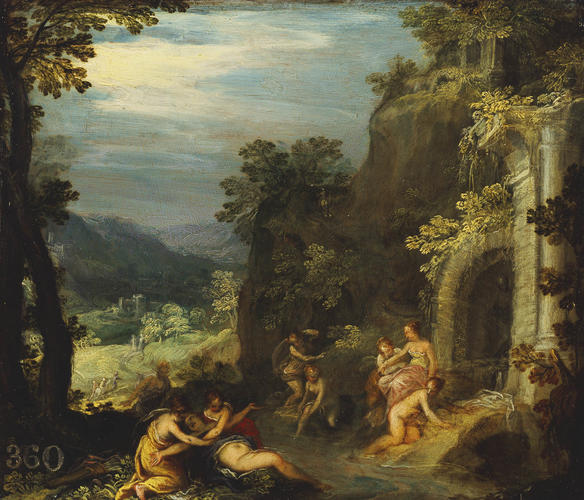Diana and Callisto c. 1602
Oil on copper | 15.0 x 18.0 cm (support, canvas/panel/stretcher external) | RCIN 403034
-
Born in Munich in 1564, Johann Rottenhammer trained under the court painter Hans Donauer. Like many artists of south Germany, Rottenhammer felt the lure of Italy. Writing in 1648, Carlo Ridolfi mentions a work by Rottenhammer dated 1589 with the signature “in Treviso”. A drawing of two floating angels in the British Museum is inscribed “Roma 18 August 1595”. During the Roman period, Rottenhammer began painting on copper and came into contact with other emigre artists, such as Paul Bril and Jan Brueghel, with whom he collaborated. Between 1595 and 1596 he returned to Venice; two religious subjects with compositions inspired by Jacopo Bassano date from 1596. Ridolfi mentions Rottenhammer was particularly impressed by Tintoretto’s monumental canvases in the Scuola di San Rocco and one drawing after Tintoretto’s Introduction of Christ in the Temple exists in the British Museum, dated 1606. In 1596 Rottenhammer married a Venetian woman, Elisabetta de Fabris. It was also in Venice that Rottenhammer came into contact with Adam Elsheimer. In 1606 Rottenhammer returned to Germany, settling in Augsburg. He received a number of commissions for large-scale altarpieces and religious works. In 1610 he was working in Bückeberg near Hannover for Count Ernst von Scharmburg, decorating the town hall's Goldener Saal. An improvident life-style meant that he incurred lavish debts and died in poverty in 1625.
Once thought to be by Jan Brueghel the Elder, this work is now attributed to Johann Rottenhammer, dating from his Venetian period (1596-1606). Popularised by classical writers such as Ovid and Hesiod, the tragedy is well-known: Jupiter, in order to escape the notice of his wife, Juno, disguises himself as the female goddess Diana and sleeps with Callisto, the most beloved of Diana's cohort of nymphs. Some months later Diana spotted Callisto's pregnant figure while bathing in a stream and expelled her from the group. Callisto then gave birth to a son, Arcas. Afterwards, seeking revenge, Juno turned Callisto into a bear. Like Titian's version of the same subject, Rottenhammer's depicts the point of Callisto's discovery. Diana is seated on the right, surrounded by her nymph coterie, her upright position exudes judgement. Diana's arm points at Callisto, who lies prostrate on the left with both arms outstretched in reaction to the accusation, held by two nymph companions. In most versions of this subject Callisto is placed horizontal along the floor, a fallen woman, as if proximity to the ground explicates the baseness of her deed, and prefigures her transformation into an animal. Despite their lack of finish, the figures are obviously drawn by a skilled hand; their confident arabesque lines show the influence of the master draughtsman Tintoretto. Rottenhammer's signature transparent modelling is visible in the wispy garments and a classic Venetian burnished red, Titian's favourite hue, has been used for Diana's clothing and for the dress of the nymph to the left of Callisto.
The most impressive feature of this painting, though, is the landscape. It is worth asking whether another hand was involved in this. We know Rottenhammer collaborated with Paul Bril and Jan Brueghel; both of them are known for depicting similar types of landscape which indulge in the hazy azure of mountainous backdrops and also in thick, bristling foliage. Jan Brueghel’s and Bril’s collaboration with Rottenhammer in paintings depicting the Rest on the Flight into Egypt (in the Mauritshuis and Los Angeles respectively), both feature a forest in the foreground giving way to valleys and mountains in the background. They are both so similar to the Royal Collection painting that it is difficult to tell which artist may have had a hand in the execution.
This painting should be dated to around 1602 by comparison with the Diana and Acteaon of 1602 (Munich), which features the same ruined antique grotto with bathing nudes in front. There is a Rottenhammer painting of bathing nymphs dated 1602 (location unknown) which, closer to the Royal Collection work, privileges the landscape (in this case a Renaissance garden) and has the similar feeling of nude figures, acting like garden statuary in their static, staged poses.
The painting appears in Pyne's illustrated 'Royal Residences' of 1819, hanging in The Queen's Closet at Kensington Palace (RCIN 922154).Provenance
First recorded in the King's Closet at Whitehall Palace in 1666 (no 368)
-
Creator(s)
Previously attributed to (artist) -
Medium and techniques
Oil on copper
Measurements
15.0 x 18.0 cm (support, canvas/panel/stretcher external)
21.8 x 24.7 x 2.4 cm (frame, external)








